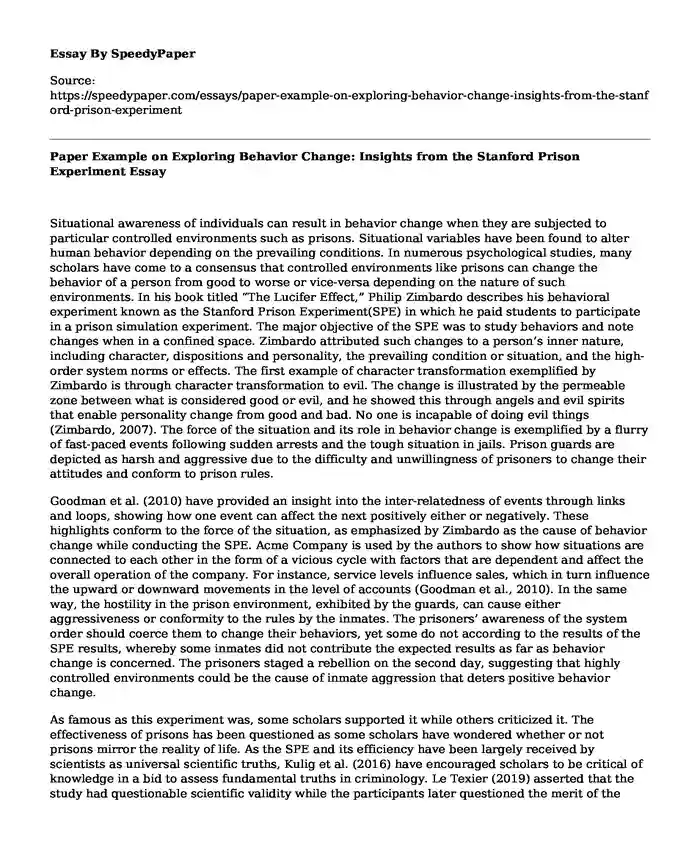
| Type of paper: | Essay |
| Categories: | Psychology Behavior change |
| Pages: | 3 |
| Wordcount: | 741 words |
Situational awareness of individuals can result in behavior change when they are subjected to particular controlled environments such as prisons. Situational variables have been found to alter human behavior depending on the prevailing conditions. In numerous psychological studies, many scholars have come to a consensus that controlled environments like prisons can change the behavior of a person from good to worse or vice-versa depending on the nature of such environments. In his book titled “The Lucifer Effect,” Philip Zimbardo describes his behavioral experiment known as the Stanford Prison Experiment(SPE) in which he paid students to participate in a prison simulation experiment. The major objective of the SPE was to study behaviors and note changes when in a confined space. Zimbardo attributed such changes to a person’s inner nature, including character, dispositions and personality, the prevailing condition or situation, and the high-order system norms or effects. The first example of character transformation exemplified by Zimbardo is through character transformation to evil. The change is illustrated by the permeable zone between what is considered good or evil, and he showed this through angels and evil spirits that enable personality change from good and bad. No one is incapable of doing evil things (Zimbardo, 2007). The force of the situation and its role in behavior change is exemplified by a flurry of fast-paced events following sudden arrests and the tough situation in jails. Prison guards are depicted as harsh and aggressive due to the difficulty and unwillingness of prisoners to change their attitudes and conform to prison rules.
Goodman et al. (2010) have provided an insight into the inter-relatedness of events through links and loops, showing how one event can affect the next positively either or negatively. These highlights conform to the force of the situation, as emphasized by Zimbardo as the cause of behavior change while conducting the SPE. Acme Company is used by the authors to show how situations are connected to each other in the form of a vicious cycle with factors that are dependent and affect the overall operation of the company. For instance, service levels influence sales, which in turn influence the upward or downward movements in the level of accounts (Goodman et al., 2010). In the same way, the hostility in the prison environment, exhibited by the guards, can cause either aggressiveness or conformity to the rules by the inmates. The prisoners’ awareness of the system order should coerce them to change their behaviors, yet some do not according to the results of the SPE results, whereby some inmates did not contribute the expected results as far as behavior change is concerned. The prisoners staged a rebellion on the second day, suggesting that highly controlled environments could be the cause of inmate aggression that deters positive behavior change.
As famous as this experiment was, some scholars supported it while others criticized it. The effectiveness of prisons has been questioned as some scholars have wondered whether or not prisons mirror the reality of life. As the SPE and its efficiency have been largely received by scientists as universal scientific truths, Kulig et al. (2016) have encouraged scholars to be critical of knowledge in a bid to assess fundamental truths in criminology. Le Texier (2019) asserted that the study had questionable scientific validity while the participants later questioned the merit of the experiment in an interview. However, some criticisms have been biased and baseless as they were based on data whose origin was unknown.
Conclusion
In conclusion, through SPE, Zimbardo conducted this experiment as a researcher trying to understand and bring to perspective the manner in which human behavior changes are influenced by a controlled environment like prisons. An individual’s personality, situation, and awareness of a system order can all contribute to how they behave, whether negatively or positively.
References
Goodman, M., Kemeny, J., & Roberts, C. (2010). The language of systems’ thinking: “link” and “loop.” In P. Senge, The Fifth Discipline: The Art & Practice of The Learning Organization (pp. 113-148). Crown.
Kulig, T., Pratt, T., & Cullen, F. (2016). Revisiting the Stanford Prison Experiment: A Case Study in Organized Skepticism. Journal Of Criminal Justice Education, 28(1), 74-111. https://doi.org/10.1080/10511253.2016.1165855
Le Texier, T. (2019). Debunking the Stanford Prison Experiment. American Psychologist, 74(7), 823-839. https://doi.org/10.1037/amp0000401
Zimbardo, P. (2007). The Lucifer effect: understanding how good people turn evil. Choice Reviews Online, 45(02), 45-1153. https://doi.org/10.5860/choice.45-1153
Cite this page
Paper Example on Exploring Behavior Change: Insights from the Stanford Prison Experiment. (2024, Jan 04). Retrieved from https://speedypaper.net/essays/paper-example-on-exploring-behavior-change-insights-from-the-stanford-prison-experiment
Request Removal
If you are the original author of this essay and no longer wish to have it published on the SpeedyPaper website, please click below to request its removal:
- Application Letter Sample for Master's Program in Clinical Mental Health Counseling
- Behavioral Assessment - Psychology Essay Sample
- Essay Example on Cultural Psychology
- Essay Sample on the Connection between Love and Therapy Culture
- Fight, Flight or Freeze Response - Essay Example
- Paper Example. Visual-Based Genre Project: Animation on Negative Peer Pressure
- Essay Example - Interplay of Individual and Group Dynamics: Insights into Organizational Behavior
Popular categories




